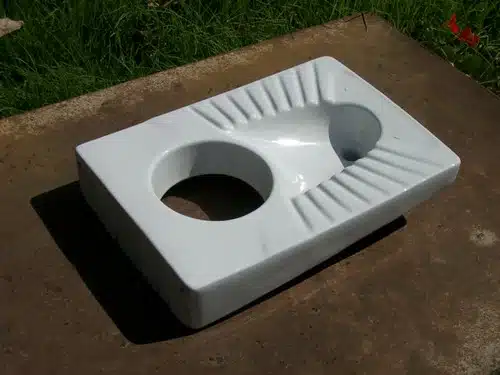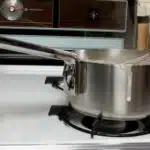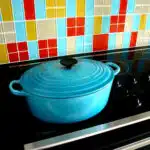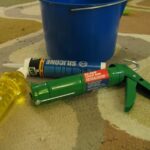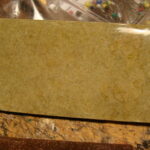Ceramic cookware is increasingly becoming a popular choice for many households due to its non-toxic and non-reactive properties. These pans and pots are not only aesthetically pleasing but also highly durable, if well taken care of. However, like any other cookware, they require regular cleaning to maintain their quality and longevity. As a ceramic cookware cleaning expert, I understand the importance of maintaining the cleanliness of your ceramic cookware to ensure that it remains in excellent condition and safe for cooking.
In this article, I will share with you some tips on how to clean your ceramic pans and other cookware effectively. Whether you are a professional chef or just starting in the kitchen, these techniques will come in handy in keeping your ceramic cookware looking as good as new. With proper cleaning practices, you can enjoy using your ceramic pots and pans for years without worrying about rusting or chipping. So sit back and learn how to give your beloved ceramic cookware the care it deserves.
The Benefits Of Using Ceramic Cookware
When it comes to choosing the right cookware for your kitchen, ceramic is an excellent option that offers various benefits. One of the biggest advantages of using ceramic cookware is its durability. Ceramic pots and pans are known to last longer than most other types of cookware, making them a smart investment in the long run.
In addition to their durability, ceramic cookware is also easy to clean and maintain. Unlike some other materials like cast iron or stainless steel, ceramic doesn’t require any special seasoning or oiling before use. It’s also dishwasher safe, making cleanup a breeze.
One of the most significant benefits of using ceramic cookware is that it’s non-reactive, meaning it won’t leach harmful chemicals into your food. This makes it an ideal choice for those who are health-conscious or have specific dietary requirements. Plus, with so many different colors and designs available on the market today, you’re sure to find a set that perfectly matches your kitchen decor.
As we delve deeper into understanding the materials used in ceramic cookware, you’ll learn about the different types available and how to choose one that suits your needs best.
Understanding The Materials Used In Ceramic Cookware
Having discussed the benefits of using ceramic cookware in the previous section, it is essential to understand the materials used in these cookware items. Ceramic cookware is made from a clay mixture that is fired at high temperatures. This process gives it durability and strength that makes it resistant to scratches and other damages.
Moreover, ceramic cookware has become increasingly popular due to its non-toxic and safe nature. Unlike some traditional non-stick coatings, ceramic coatings are free from harmful chemicals such as PFOA and PFTE. It means that you can cook your meals without worrying about any harmful substances leaching into your food.
Despite its durability and safety benefits, ceramic cookware requires proper care and maintenance to serve you well for long periods. Cleaning ceramic pans can be challenging if not done correctly. In the next section, we will discuss how to clean ceramic pans and other types of ceramic cookware effectively. But first, let us take a closer look at how to identify different types of ceramic cookware.
How To Identify Different Types Of Ceramic Cookware
As a ceramic cookware cleaning expert, it is essential to know how to identify different types of ceramic cookware. Ceramic cookware comes in various shapes and sizes, and each type has its benefits. To begin with, there are two main types of ceramic cookware: glazed and unglazed. Glazed ceramic cookware is coated with a layer of glass on the surface, making it non-porous and easy to clean. In contrast, unglazed ceramic cookware is porous and requires more maintenance to prevent staining.
Another way to identify different types of ceramic cookware is by their shape. Ceramic pots and pans come in different shapes such as round, oval, square, or rectangular. Each shape has its benefits depending on the type of cooking you do. Round-shaped pots are ideal for stews and soups while square-shaped pans are perfect for frying or sautéing vegetables.
The benefits of ceramic cookware shapes go beyond just aesthetics; they can also affect how food cooks inside the pan or pot. For example, oval-shaped pots distribute heat evenly throughout the food due to their elongated shape. On the other hand, rectangular pans are great for baking since they have flat bottoms that allow for even heat distribution across the surface area.
As a ceramic cookware cleaning expert, identifying different types of ceramic cookware is crucial before proceeding with any cleaning method. Understanding the benefits of each shape can help you choose what type of pan or pot is best suited for your cooking needs. In the next section, we will discuss common mistakes to avoid when cleaning ceramic cookware so that your beloved pots and pans stay in tip-top condition for years to come.
Common Mistakes To Avoid When Cleaning Ceramic Cookware
- Not using soap when cleaning ceramic cookware can be an issue as soap helps to loosen grease and food particles.
- It is important to thoroughly rinse ceramic cookware after washing to ensure all residue from soap and food particles are removed.
- Not drying ceramic cookware completely can cause staining and streaks to form on the surface.
- It is recommended to use a soft cloth to dry ceramic cookware to prevent scratches from forming.
- Too much soap should be avoided when cleaning ceramic cookware as residue from soap can accumulate and create a dull finish.
- It is important to avoid using abrasive scrubbing tools or pads when cleaning ceramic cookware as these can scratch and damage the surface.
Not Using Soap
As a ceramic cookware cleaning expert, I’ve seen many people make the mistake of using soap when cleaning their ceramic pans. While it may seem like the obvious choice, using soap can actually damage the non-stick coating on your pan. Instead, consider alternative cleaning methods that don’t involve soap.
One such method is to use a mixture of baking soda and water. This gentle abrasive can help lift off any food residue without damaging your pan. Simply mix the two together to form a paste and use a soft sponge or cloth to scrub away any stubborn spots. Another option is to use vinegar and water to soak your pan for a few minutes before wiping it clean with a soft cloth.
While soap-free cleaning has its benefits, there are also some cons to consider. For one, it may not be as effective at removing tough stains or burnt-on food as traditional soap and water. Additionally, if you’re cooking meat or other foods that could harbor harmful bacteria, soap may be necessary for proper sanitation. Ultimately, whether or not to use soap when cleaning your ceramic cookware will depend on your personal preferences and needs.
In conclusion, while using soap may seem like the easiest way to clean your ceramic pans, it’s important to consider alternative methods that won’t damage the non-stick coating. However, keep in mind that these methods may not be as effective at removing tough stains or sanitizing your cookware as traditional soap and water. Consider your options carefully and choose the method that works best for you and your needs.
Not Rinsing Thoroughly
Proper drying is an essential step in cleaning ceramic cookware, yet it’s a common mistake that many people overlook. After washing your pan, it’s crucial to ensure that it’s completely dry before storing it. Leaving any moisture on the surface can lead to mold or bacteria growth, which can be harmful to your health. To properly dry your ceramic cookware, use a soft cloth or paper towel to wipe away any excess water. Then, let it air dry completely before putting it away.
Another mistake to avoid when cleaning ceramic cookware is not rinsing thoroughly. While it may seem like a minor detail, failing to rinse your pan properly can leave behind residue that could affect the taste of your food and even cause health problems. To ensure that you’ve rinsed your pan thoroughly, run it under hot water for at least 30 seconds while scrubbing with a soft sponge or cloth. Make sure there are no visible traces of food or soap left on the surface.
In addition to proper drying and thorough rinsing, avoiding harsh cleaners is also essential when cleaning ceramic cookware. Abrasive cleaners or scouring pads can scratch the surface of your pan and damage the non-stick coating, making it less effective over time. Instead, opt for gentle cleaning methods like baking soda and vinegar solutions or specialized ceramic cookware cleaners. By using these products and techniques correctly, you can prolong the life of your pan and ensure that it remains in top condition for years to come.
Not Drying Properly
Proper cleaning and maintenance of ceramic cookware are crucial to ensuring its longevity and effectiveness. However, many people make common mistakes that can damage their precious kitchen tools. One such mistake is improper drying of the cookware after washing it. Improper drying can lead to rusting, which can affect the non-stick coating and make it less effective over time.
To prevent rusting caused by improper drying, it’s essential to ensure that the ceramic cookware is completely dry before storing it. Leaving any moisture on the surface can cause rust or corrosion, which can be challenging to remove. To properly dry your cookware, wipe away any excess water using a soft cloth or paper towel and let it air dry completely before putting it away.
Not only does improper drying lead to rusting, but it also creates an environment where mold and bacteria growth can thrive. This can pose health risks when using the cookware again. Therefore, preventing such growth by proper drying is necessary for maintaining good health and hygiene in your kitchen. By taking these simple steps, you’ll prolong the life of your ceramic cookware and enjoy its benefits for years to come.
Preparing Your Ceramic Cookware For Cleaning
Before cleaning your ceramic cookware, it is essential to prepare it properly. The first step is pre-soaking the dishes in warm water for a few minutes. This will help loosen any stuck-on food particles and make them easier to remove during the cleaning process. It is important not to skip this step as it can save you time and effort in the long run.
Choosing the right cleaning tools is also crucial in preparing your ceramic cookware for cleaning. Avoid using abrasive sponges or steel wool as they can scratch the surface of your pans and pots. Instead, opt for soft-bristled brushes or non-abrasive scrubbers that are specifically designed for use on ceramic surfaces. You may also use dish soap and baking soda as natural cleaning agents that are gentle yet effective in removing stubborn stains and grime.
Having a well-prepared ceramic cookware set makes cleaning much easier and less time-consuming. By pre-soaking your dishes and choosing the right cleaning tools, you can effectively remove any dirt or grime without damaging your pans or pots. In the next section, we will discuss basic cleaning techniques that you can use to keep your ceramic cookware looking its best.
Basic Cleaning Techniques For Ceramic Cookware
When it comes to cleaning ceramic cookware, there is no avoiding the fact that it can be a tedious task. However, proper maintenance of your ceramic pans and pots will not only extend their lifespan but also ensure that they perform optimally with every use. Basic cleaning techniques for ceramic cookware are essential to know if you want to maintain their pristine appearance and functionality.
To get started on basic cleaning, gather cleaning solutions such as dish soap or vinegar, hot water, and a soft sponge or cloth. First, rinse your cookware under hot water to remove any loose debris. Then, apply dish soap or vinegar to the surface of the pan and scrub gently with a soft sponge or cloth. Finally, rinse with hot water and dry thoroughly before storing.
To prevent scratches on your ceramic cookware, avoid using abrasive sponges or steel wool pads. Instead, opt for softer materials like microfiber cloths or natural-fiber brushes. Also, refrain from using high-heat settings when cooking with ceramic pans as this can damage the non-stick coating over time. By following these simple maintenance tips regularly, you can keep your ceramic cookware in top condition for many years to come.
Moving forward, if you find that basic cleaning techniques don’t cut it in removing stubborn stains from your ceramic cookware’s surface, deep cleaning may be necessary. In the subsequent section we’ll delve into how to effectively deep clean your ceramic cookware without causing any damage in the process.
Deep Cleaning Your Ceramic Cookware
Maintaining the cleanliness of your ceramic cookware is essential to ensure its longevity. The build-up of grease, burnt-on food, and stains can damage the non-stick surface and affect the quality of your cooking. One effective way to deep clean your ceramic pans is through the boiling method.
Boiling method involves heating a mixture of water and baking soda in your pan until it boils. This process helps to loosen any food particles that have stuck onto the surface, making it easier to scrub off. Once the solution has boiled for several minutes, turn off the heat and let it cool down before disposing of it. You can then proceed to wash your pan with dish soap and warm water to remove any remaining residue.
Another option for deep cleaning your ceramic cookware is by using a baking soda solution. Mix equal parts baking soda and water until it forms a thick paste-like consistency. Apply this mixture onto the affected area and let it sit for up to 30 minutes before rinsing off with warm water. Baking soda is an excellent natural cleaner that removes stubborn stains without being abrasive on your cookware’s surface.
Deep cleaning your ceramic cookware regularly will keep them looking good as new and improve their performance over time. However, in cases where you have tough stains or burnt-on residue that won’t come off easily, you’ll need more specialized methods to get rid of them completely. The next section will provide tips on how to remove these stubborn marks from your ceramic pans effectively without causing any harm to their surface.
Removing Tough Stains And Burnt-On Residue
Removing tough stains and burnt-on residue from ceramic cookware can be a daunting task. However, with the right tools and effective cleaning methods, it is possible to restore your cookware to its former glory. When dealing with burnt residue on your ceramic pans, avoid using abrasive sponges or harsh chemicals that may damage the surface of the pan. Instead, opt for gentle cleaning agents such as baking soda or vinegar.
To remove burnt residue from your ceramic pans, start by filling them with water and adding a tablespoon of baking soda. Bring the water to a boil and let it simmer for about 10 minutes before turning off the heat and allowing the mixture to cool down. Once cooled, empty the pan and scrub it gently using a soft-bristled brush or sponge. If there are still stubborn stains remaining, repeat the process until they disappear.
Another effective cleaning method for removing tough stains from ceramic cookware is by using white vinegar. Simply pour a small amount of vinegar into the pan and let it sit for about 30 minutes before rinsing it out with warm water. For particularly stubborn stains, you can add some salt to the vinegar solution to create an abrasive paste that will help break down any burnt-on residue.
Overall, removing burnt residue from ceramic cookware requires patience and careful attention to detail. By utilizing these effective cleaning methods, you can ensure that your ceramic pans remain in pristine condition for years to come.
Moving forward with maintaining non-stick properties of ceramic cookware, there are several tips that will keep your pans looking new even after multiple uses.
Tips For Maintaining The Non-Stick Properties Of Ceramic Cookware
Maintaining the Non-stick Properties of Ceramic Cookware
Maintaining longevity and preventing damage to your ceramic cookware is essential for keeping its non-stick properties intact. Here are some tips on how to maintain your ceramic cookware properly:
Firstly, always use non-metal utensils such as wooden or silicone spoons to avoid scratching the surface of the pan. Scratches can cause damage to the non-stick coating, leading to food sticking and burning. Additionally, avoid cooking acidic foods for prolonged periods in ceramic cookware since this can also cause damage to the non-stick layer.
Secondly, be mindful of how you stack your ceramic cookware in storage. Avoid stacking heavy pans on top of each other as this can lead to chips and scratches on the bottom surface of the pans. Always store your ceramic cookware safely and separately from other kitchen items.
Lastly, always clean your ceramic cookware with mild dish soap and a soft sponge or cloth. Harsh abrasives like steel wool or rough sponges can scratch off the non-stick coating over time, causing it to lose its effectiveness.
By following these simple steps, you can maintain your ceramic cookware’s non-stick properties for longer and prevent any unnecessary damage that may render it unusable over time.
Moving forward, let us take a closer look at how avoiding scratches and chips in your ceramic cookware can help extend its lifespan even further.
Avoiding Scratches And Chips In Your Ceramic Cookware
It is a common misconception that ceramic cookware is indestructible. While it is true that ceramic pans and pots are known for their durability, they are not entirely scratch-proof. In fact, if not properly cared for, scratches and chips can occur more frequently than you think. This is why it is crucial to learn how to prevent damage and maintain longevity of your ceramic cookware.
Preventing damage starts with avoiding the use of metal utensils when cooking in your ceramic pans or pots. Metal utensils can easily scratch the surface of your cookware, leaving it vulnerable to further damage. Instead, opt for wooden or silicone utensils that are gentler on the surface of your cookware.
Another way to prevent damage is by cleaning your ceramic cookware properly. Avoid using abrasive sponges or scrubbers as these can also leave scratches on the surface of your pan or pot. Instead, use a soft sponge or cloth with mild dish soap and warm water to clean your cookware thoroughly.
To maintain longevity of your ceramic cookware, follow these simple steps:
- Always let your pan or pot cool down before washing it.
- Avoid stacking other heavy items on top of your ceramic cookware when storing it.
- Store each piece separately from one another to avoid scratching.
- Do not use high heat settings when cooking in your ceramic pans/pots.
- Regularly check for chips or cracks and replace them immediately to avoid further damage.
By following these preventative measures, you can ensure that your ceramic cookware will last for years to come. In the next section, we will discuss how to store your ceramic cookware properly to further extend its lifespan.
Storing Your Ceramic Cookware Properly
After learning how to avoid scratches and chips in your ceramic cookware, it’s important to know that proper storage is also a crucial aspect of maintaining the quality of your cookware. Storing your ceramic cookware properly can help prevent damage and increase its lifespan.
One tip for proper storage is to stack your ceramic cookware with care. It’s best to place a soft cloth or paper towel between each piece to prevent scratches or chips. Additionally, it’s important to avoid stacking heavy items on top of delicate pieces as this can cause damage over time.
Organization is also key when storing ceramic cookware. Keep your pieces together in one designated area so that they are easy to find and access when needed. You may want to consider investing in a pot rack or hanging system if you have limited cabinet space. This not only keeps your cookware organized but also adds a decorative element to your kitchen.
Transition: While properly storing your ceramic cookware is essential, it’s equally important to keep all accessories and utensils clean for optimal performance. Here are some tips for cleaning ceramic cookware accessories and utensils.
Cleaning Ceramic Cookware Accessories And Utensils
Imagine a beautiful garden filled with blooming flowers. You want to keep it looking pristine, so you take care of the weeds and trim the hedges. In much the same way, cleaning your ceramic cookware is essential to keeping it in top condition. This includes not only your pots and pans but also your utensils.
Cleaning ceramic utensils may seem like a daunting task, but it doesn’t have to be. The key is using gentle products that won’t damage the delicate surface of the ceramics. Begin by rinsing off any food debris and then using a soft sponge or cloth to wash them with warm, soapy water. Avoid using abrasive materials like steel wool or harsh chemicals that can scratch or stain your ceramics.
Removing stains from ceramic pans can be tricky but not impossible. Start by soaking the pan in warm soapy water for 15-20 minutes to loosen any stuck-on food particles. Next, sprinkle baking soda over the stained area and add enough vinegar to create a paste. Let it sit for about 10 minutes before scrubbing gently with a non-abrasive sponge or cloth. Rinse thoroughly and dry with a soft towel.
When it comes to cleaning your ceramic cookware accessories and utensils, remember to handle them with care and use gentle cleaning agents that won’t damage their delicate surface. By following these simple steps, you’ll be able to keep your ceramics looking beautiful for years to come. In the next section, we will discuss how natural cleaning agents can be used as an alternative method for maintaining your ceramic cookware’s cleanliness.
Using Natural Cleaning Agents For Your Ceramic Cookware
- Baking soda is an effective natural cleaning agent for ceramic cookware and can be used to remove stains or build-up from the cookware’s surface.
- When mixed with water, baking soda can be used to create a paste which can be applied to the cookware surface and then rinsed off, leaving a clean and shinny surface.
- Vinegar is another effective natural cleaning agent which can be used to clean ceramic cookware.
- Vinegar can be used to remove stains, grease, and other build-ups from ceramic cookware surfaces.
- Lemon juice is a natural degreaser and can be used to remove grease and other oily residue from ceramic cookware.
- Lemon juice can also be used in combination with baking soda and vinegar to create a natural cleaning solution which can be used to clean ceramic cookware.
Baking Soda
When it comes to cleaning ceramic pans and cookware, using natural cleaning agents can be a great way to keep your kitchen chemical-free. Baking soda is one such agent that has been used for centuries due to its effectiveness and affordability. If you’re looking for an easy and safe way to clean your ceramic cookware, baking soda might just be the solution you need.
Using baking soda is simple. Start by sprinkling some baking soda on the surface of the pan or cookware. Then, add a few drops of vinegar on top of the baking soda. You’ll notice a reaction between the two ingredients as they start fizzing up. This reaction helps loosen any grime or stains from the surface, making it easier to remove them.
One of the most significant benefits of using baking soda is that it’s effective at removing discoloration from ceramic pans and cookware. Whether it’s burnt-on food or stains caused by cooking oils, baking soda can help restore your cookware’s original shine. By regularly using this natural cleaning agent, you can keep your ceramic pans looking new for years to come without exposing yourself or your loved ones to harmful chemicals.
Vinegar
As a ceramic cookware cleaning expert, I highly recommend using natural cleaning agents to keep your kitchen chemical-free. One such agent is vinegar, which has been used for centuries due to its effectiveness and versatility. Using vinegar can be a great way to clean your ceramic pans and cookware without exposing yourself or your loved ones to harmful chemicals.
Using vinegar is straightforward. Start by filling the pan or cookware with enough water to cover the surface you want to clean. Then, add a cup of vinegar and let it soak for at least an hour, depending on how dirty the surface is. The acetic acid in vinegar helps break down grease and grime, making it easier to remove them.
One of the most significant benefits of using vinegar is that it’s effective at removing stubborn stains and discoloration from ceramic pans and cookware. By soaking them in vinegar, you can restore their original shine and make them look new again. Additionally, using vinegar regularly can help prevent future stains from forming, keeping your cookware looking great for years to come. So next time you need to clean your ceramic pans or cookware, consider using vinegar as a natural cleaning agent.
Lemon Juice
As a ceramic cookware cleaning expert, I highly recommend using natural cleaning agents to keep your kitchen chemical-free. Vinegar is an excellent option for cleaning ceramic pans and cookware, but there are other citrus-based alternatives that you can use. One of these alternatives is lemon juice, which has been used for its cleansing properties for centuries.
Using lemon juice for cleaning ceramic pans is simple and effective. Start by squeezing fresh lemon juice onto the surface of the pan or cookware you want to clean. Then, sprinkle some salt over it and use a scrub brush or sponge to work the mixture into the surface gently. The citric acid in the lemon juice helps break down grease and stains, while the salt acts as an abrasive to remove any remaining debris.
One of the benefits of using citrus cleaning agents like lemon juice is that they are all-natural and safe to use around food and people. Lemon juice also has a pleasant scent that can leave your cookware smelling fresh and clean. Additionally, using natural cleaning agents can help extend the lifespan of your ceramic pans and cookware by preventing damage from harsh chemicals. So next time you need to clean your ceramic pans or cookware, consider using lemon juice as an effective and safe alternative to traditional cleaners.
Troubleshooting Common Ceramic Cookware Issues
Common ceramic pan issues can arise with regular use, but there are simple solutions to troubleshoot these problems. One common issue is food sticking to the pan, which can be caused by not using enough oil or cooking on high heat. To fix this, try adding more oil or reducing the heat. Another issue is discoloration or stains on the surface of the pan, which can be caused by acidic foods or improper cleaning methods. To remove these stains, try using a baking soda and water paste or vinegar and water solution.
Another common ceramic cookware issue is chipping or scratching of the non-stick surface. This can happen if metal utensils are used instead of silicone or wooden utensils. If the damage is minor, it may still be safe to use the pan but if it interferes with cooking performance then it’s time to replace it. It’s also important to avoid stacking pans as this can cause scratches and damage to the non-stick coating.
Cleaning ceramic cookware is essential for maintaining its quality and longevity. A step-by-step guide includes soaking in hot soapy water for 10-15 minutes before scrubbing with a soft sponge or cloth. Avoid using abrasive materials like steel wool which can scratch the surface of the pan. Rinse thoroughly and dry immediately with a soft towel to prevent watermarks from forming on the surface. With proper care and maintenance, your ceramic cookware will last for many years without any issues.
Moving forward into frequently asked questions about cleaning ceramic cookware, many people wonder about whether it’s safe to put these pans in the dishwasher or how often they should be deep cleaned. Let’s explore some of these questions together in order to help you maintain your ceramic cookware with ease!
Frequently Asked Questions About Cleaning Ceramic Cookware
Cleaning ceramic cookware is essential to maintain its quality and prolong its lifespan. However, many individuals are unsure about the best ways to clean their ceramic pans and cookware. In this section, we will answer some frequently asked questions about cleaning ceramic cookware.
- What are some cleaning hacks for ceramic cookware?
- Use baking soda: Sprinkle baking soda on your pan and scrub with a damp sponge to remove tough stains.
- Soak in vinegar: Fill your pan with equal parts water and vinegar, let it soak for an hour, then wash with soap and water.
- Avoid metal utensils: Use wooden or silicone utensils to prevent scratches on your ceramic pan’s surface.
- What are the best cleaning products for ceramic cookware?
There are several cleaning products available in the market specially designed for cleaning ceramic cookware. Some of the best ones include:
- Bar Keepers Friend: It effectively removes stubborn stains without damaging the surface of your pans.
- Cerama Bryte Cooktop Cleaner: This cleaner works wonders on both glass stovetops and ceramic pans.
- Weiman Ceramic & Glass Cooktop Cleaner: It is an excellent option for those who want a more natural solution as it contains no harsh chemicals.
- How often should I clean my ceramic cookware?
It is recommended to clean your ceramic cookware after every use to prevent food residue buildup that can cause staining or affect its performance over time. If you notice any discoloration or stains despite regular cleaning, use one of the cleaning hacks mentioned above or try one of the best cleaning products recommended.
In summary, knowing how to properly clean your ceramic pans and cookware is crucial in ensuring their longevity and maintaining their quality. With these tips on cleaning hacks and best cleaning products, you can keep your ceramic pots and pans in top shape for years to come!
Conclusion
Ceramic cookware is a popular choice among home cooks due to its non-stick properties, durability, and ability to distribute heat evenly. However, maintaining its pristine condition requires proper cleaning techniques. Understanding the materials used in ceramic cookware and identifying the different types are crucial steps towards effective maintenance.
Common mistakes to avoid include using abrasive cleaning tools such as steel wool or harsh chemicals that can damage the surface of your pans. Preparing your cookware for cleaning involves soaking it in warm water and removing any food residue. Natural cleaning agents like baking soda, vinegar, and lemon juice are safe alternatives that effectively remove stains and odors.
In conclusion, keeping your ceramic cookware clean not only preserves its beauty but also ensures it performs at its best. Remember to handle them with care and use proper cleaning methods to prevent damage. As the saying goes, “an ounce of prevention is worth a pound of cure.” By following these tips, you can enjoy your ceramic cookware for years to come.
Image Credits
- “Ceramic UDD squatting pan from Ehtiopia – 1” by Sustainable sanitation (featured)

